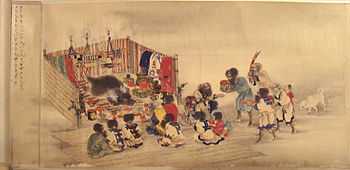Iomante



Iomante (イオマンテ) is the name of an Ainu ceremony. The word literally means "to send something/someone off", and generally refers to the Ainu brown bear sacrifice. However, in some Ainu villages, it is a Blakiston's Fish Owl, rather than a bear, that is sacrificed. In Japanese, the ceremony is known as "sending off the bear" (熊送り kumaokuri) or, sometimes, "the bear festival" (熊祭 kumamatsuri). The ceremony is perhaps the most famous (and controversial) part of Ainu culture.
Hokkaido encouraged local governments to abolish the Iomante in 1955, but the circular notice was abolished in April 2007, because the Ministry of the Environment of Japan announced that animal ceremonies were generally regarded as an exception of the animal rights law of Japan in October 2006.[1]
Trappers set out to the bear caves at the end of winter, while the bears are still hibernating. If they find a newborn cub, they kill the mother and take the cub back to the village, where they raise it indoors, as if it were one of their own children. It is said that they even provide the cub with their own breast milk. When the cub grows larger, they take it outdoors, and put it into a small pen made of logs. Throughout their lives, the bears are provided with high-quality food. The cubs are treated as, and traditionally believed to be, gods.
After the cub reaches one or two years of age, they release it from the cell and place it in the center of the village, where it is tied to a post with a rope. The males in the village then take shots at the cub with bows and arrows. Even at the age of two years, the brown bears are quite large, and it usually takes numerous shots before they fall. After the bear has been weakened from numerous arrow strikes and is too weak to defend itself, one villager will approach the bear and shoot it in the neck point-blank, to ensure that it is dead. The villagers then slit the bear's throat and drink the blood. The bear is skinned, and the meat is distributed amongst the villagers. Its bare skull is placed on a spear, which is then rewrapped with the bear's own fur. This "doll" is an object of worship for the villagers. The bear has now been "sent off" to the world of the gods.
Iomante videos and artifacts are on display at the Nibutani Ainu Culture Museum in Nibutani, Hokkaidō.
See also
- Peijainen, a bear sacrifice ritual of Finland
- Bear worship#Nivkh_Bear_Festival, the ritual sacrifice of bears among Nivkhs of Sakhalin.
References
- ↑ "イヨマンテ禁止通達を撤廃 アイヌ儀式、52年ぶり". 47 News (in Japanese). Press Net Japan Co., Ltd. April 28, 2007. Retrieved March 4, 2011.
Some of the content of this article was taken from the equivalent Japanese-language Wikipedia article (accessed April 10, 2006).
See also
- List of Ainu terms
- Bear worship
- Cruelty to animals